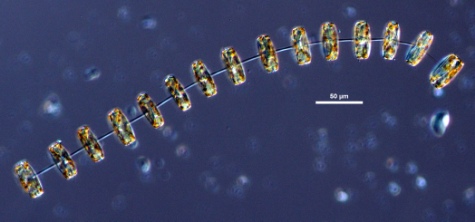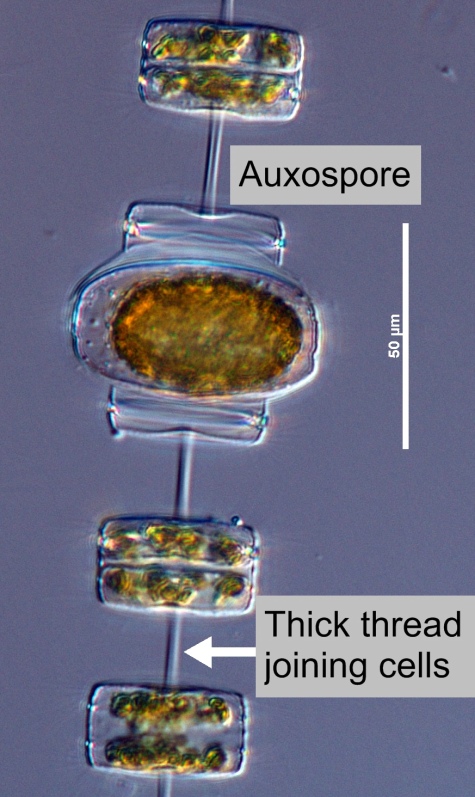




|
Synonym(s)
Classification
(Guiry and Guiry 2012)
Lifestyle
Description
Discoid
Disc-shaped.
discoid and connected in a chain by a thick bundle of threads. Threads extend from a cluster of central CloseStrutted process
(how is this different than marginal process?) In some diatoms, a narrow tube through the frustule that is usually associated with the secretion of chitin. It may appear as a marginal process or as a simple pore in the valve wall (Spaulding et al. 2010).
strutted processes (Hasle and Syvertsen 1997). The CloseValve
In diatoms, the structurally distinct halves of the cell wall (Becker 1996).
valve CloseMargin
The outline or border that defines the shape of an organism or cell.
margins are slightly rounded, and each valve has one CloseIntercalary bands
Girdle bands that are furthest away from the valve (Smithsonian 2011).
intercalary band which is unevenly thickened. Chloroplasts are numerous, small, and distributed near the cell wall (Cupp 1943).Radial
(symmetry) Describing a shape that many axes of symmetry. That is, it does not have a left and right like humans do (bilateral symmetry), but can be divided into equal halves no matter where you place the axis. Some examples of radially symmetrical organisms include sea stars and centric diatoms like Thalassiosira.
radial CloseRibs
Features that provide support to other structures in the cell.
ribs and the CloseMantle
In diatoms, "the part of a valve that extends from the valve face, forming the valve edge." It is visible when the frustule is viewed in girdle view (Spaulding 2010).
mantle is covered with CloseAreola(e)
In diatoms, the regularly repeated hexagonal holes on the valve walls (HPP 2003).
areolae (Kraberg et al. 2010). One CloseLabiate process
In diatoms, a simple slit in the valve wall with two internal lips, one on each side of the slit. They can be useful in identification because they are positioned differently in different species (Horner 2002).
labiate process with external tubes is present near the valve mantle. Additional strutted processes are also distributed throughout the valve surface (Horner 2002) and near the margins (Kraberg et al. 2010).Measurements
Height: 5 - 20 μm
Valve areolae: 18 - 24 in 10 μm
Close
Marginal process
In some diatoms, a long, coarse external tube through the frustule (Tomas 1997).
Marginal processes: 12 - 15 in 10 μm(Hasle and Syvertsen 1997, Kraberg et al. 2010)
Similar species
Harmful effects
Habitat
Distribution
Cosmopolitan (Hasle and Syvertsen 1997).
Can be very abundant during spring and summer in Northern European seas (Kraberg et al. 2010).
Abundant during late spring and early fall, and present in low numbers throughout the summer.
Growth conditions
Lux
(abbreviated 'lx') Units for measuring light intensity in a given surface area.
lux (Schone 1972) and salinity of 20 - 33. Salinity below 20 or above 38 would likely damage or kill the cells (Schone 1974). May be favoured by high N levels (Hobson and McQuoid 2001). Often forms blooms during summer CloseUpwelling
A wind-driven mechanism of mixing the water column. Cold, dense, nutrient-rich, and often oxygen-poor water from depths rises to replace the warmer nutrient-poor surface water. This input of nutrients can have a significantly increase primary productivity in a region (Dugdale 1985).
upwellings (Raine et al. 1993).Environmental Ranges
Temperature range (°C): -1.421 - 26.001
Nitrate (μmol L-1): 0.135 - 16.590
Salinity: 29.305 - 36.252
Oxygen (mL L-1): 4.705 - 8.401
Phosphate (μmol L-1): 0.048 - 1.441
Close
Silicic acid
A general term to describe chemical compounds containing silicon, oxygen and hydrogen with a general formula of [SiOx(OH)4-2x]n. Diatoms polymerize silicic acid into biogenic silica to form their frustules (Azam and Chisholm 1976).
Silicate (μmol L-1): 0.754 - 31.065(OBIS 2012, cited in EOL 2012)
Bloom characteristics
References
Barreiro, A. Carotenuto, Y., Lamari, N., Esposito, F., D'Ippolito, G., Fontana, A., Romano, G., Ianora, A., Miralto, A. and Guisande, C. 2011. Diatom induction of reproductive failure in copepods: The effect of PUAs versus non-volatile oxylipins. Journal of Experimental Marine Biology and Ecology. 401(1-2): 13-19.
Cupp, E. E. 1943. Marine Plankton Diatoms of the West Coast of North America. University of California Press. Berkeley, California. 238.
Encyclopedia of Life (EOL). 2012. Thalassiosira rotula. http://eol.org/pages/915756/overview. Accessed 19 Feb 2012.
Guiry, M. D. 2011. Thalassiosira rotula Meunier, 1910. http://www.marinespecies.org/aphia.php?p=taxdetails&id=148942. Accessed 19 Feb 2011.
Guiry, M. D. and Guiry, G. M. 2012. Thalassiosira rotula Meunier. http://www.algaebase.org/search/species/detail/?species_id=33071. Accessed 19 Feb 2012.
Hasle, G. R. and Syvertsen, E. E. 1997. Marine diatoms. In: Tomas, C. R. (ed.) Identifying Marine Phytoplankton. Academic Press, Inc., San Diego. 5-385.
Hobson, L. A. and McQuoid, M. R. 2001. Pelagic diatom assemblages are good indicators of mixed water intrusions into Saanich Inlet, a stratified fjord in Vancouver Island. Marine Geology. 174(1-4): 125-138.
Horner, R. A. 2002. A Taxonomic Guide To Some Common Phytoplankton. Biopress Limited, Dorset Press, Dorchester, UK. 200.
Kraberg, A., Baumann, M. and Durselen, C. D. 2010. Coastal Phytoplankton: Photo Guide for Northern European Seas. Verlag Dr. Friedrich Pfeil, Munchen, Germany. 204.
Ocean Biogeographic Information System (OBIS). 2012. Thalassiosira rotula. http://www.iobis.org/mapper/?taxon_id=518630. Accessed 19 Feb 2012.
Raine, R., Joyce, B., Patching, J. W., McMahon, T. and Roden, C. 1993. Upwelling and the phytoplankton ecology of southwest Irish coastal waters. ICES, Copenhagen, Denmark. 18.
Schone, H. 1972. Experimental investigations on the ecology of the marine diatom Thalassiosira rotula. I. Temperature and light. Marine Biology. 13(4): 284-291.
Schone, H. 1974. Experimental investigations on the ecology of the marine diatom Thalassiosira rotula. II. Influence of salinity. Marine Biology. 27(4): 287-298.
